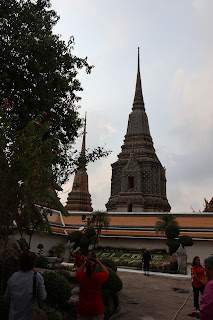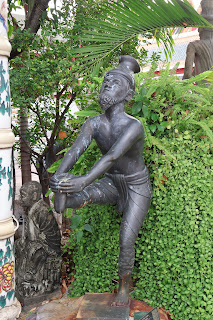Wat Pho, also spelled Wat Po, is a Buddhist temple complex in the Phra Nakhon
District, Bangkok, Thailand.
It is on Rattanakosin Island, directly south of the Grand Palace. Known also
as the Temple of the Reclining Buddha.
The temple is first on the list of six temples in Thailand classed as the
highest grade of the first-class royal temples.
It is associated with King Rama I who rebuilt the temple complex on an earlier
temple site. It became his main temple and is where some of his ashes are
enshrined.
The temple was later expanded and extensively renovated by Rama III.
The temple complex houses the largest collection of Buddha images in Thailand,
including a 46 m long reclining Buddha.
|
Wat Pho Plan.
Plan Legend:
- Phra Ubosot
- Kamphaeng kaew
- East Viharn
- South Viharn
- West Viharn
- North Viharn
- Phra Prang
- 5 Chedis with a single base
- Phra Chedi Rai
- Phra Rabiang
- Phra Viharn Kod
- Khao Mor (rock gardens)
- Phra Maha Chedi Si Rajakarn
- Phra Mondop
- Pavilions
- Viharn Phranorn (Chapel of the Reclining Buddha)
- Sala Karn Parien
- Missakawan Park
- The Crocodile Pond
- Belfry
- Gates
- Massage service
- Sala Rai
-
Photograph by Heinrich Damm, distributed under a CC-BY 4.0 license.
|
|
East gate (Plan No. 23).
East gate (Plan No. 23) to Wat Pho on Sanam Chai Street.
|
|
East pavilion (Plan No. 3).
East pavilion (East Viharn) (Plan No. 3) of the ordination hall (Phra
Ubosot) (Plan No. 1) of Wat Pho viewed from the east gate (Plan No. 23)
on Sanam Chai Street.
|
|
Giant gate guardians.
Two giant gate guardians of the north gate of the Chapel of the
Reclining Buddha (Viharn Phranorn) (Plan No. 16).
|
|
North entrance to the Reclining Buddha Chapel.
The northern entrance to the Reclining Buddha Chapel (Plan no. 16) has
two smaller gate guardians on each side.
- On the left side of the door we can hit a large nipple gong.
|
|
North annex pavilion.
Annex pavilion located north of the Chapel Reclining Buddha Chapel (Plan
no. 16).
-
Inside we can see the statues of the Buddhas of the seven days of the
week, as well as the statues of certain famous monks.
- We can also see believers worshiping before these statues.
|
|
North gate next to the east entrance of the chapel.
This gate also has two giant gate guardians, one on each side of the
gate.
-
The expression and clothing of these two guardians is different in
some aspects from the expression and clothing of the other two
guardians.
|
|
East entrance to the chapel.
The east side of the chapel has three doors, the north door serves as
the entrance and the south door serves as the exit.
-
The wat and the reclining Buddha (Phra Buddhasaiyas) were built
by Rama III in 1832.
|
|
Head of the Reclining Buddha.
The image of the reclining Buddha represents the entry of Buddha into
Nirvana and the end of all reincarnations.
-
The posture of the image is referred to as sihasaiyas, the
posture of a sleeping or reclining lion.
-
See more at
Parinirvana - Wikipedia.
|
|
Right arm of the Buddha.
The right arm of the Buddha supports the head with tight curls, which
rests on two box-pillows encrusted with glass mosaics.
|
|
Small altars with offerings.
At intervals there are small altars with offerings to the Reclining
Buddha.
|
|
Haed and torso of the Reclining Buddha.
The figure has a brick core, which was modelled and shaped with plaster,
then gilded.
-
The figure is 15 m (50 ft) high and 46 m (150 ft) long, and it is one
of the largest Buddha statues in Thailand.
|
|
Legs and feet of the Reclining Buddha.
Note that the left foot is positioned right on top of the right foot,
and that the robe of the Buddha is such as it would be if he was
standing up.
|
|
Soles of the feet of the Buddha.
The soles of the feet of the Buddha are 3 m (9.8 ft) high and 4.5 m
(14.7 ft) long, and inlaid with mother-of-pearl.
-
They are each divided into 108 arranged panels, displaying the
auspicious symbols by which Buddha can be identified, such as flowers,
dancers, white elephants, tigers, and altar accessories.
-
At the center of each foot is a circle representing a chakra or
'energy point'.
-
See more at
Buddha footprint - Wikipedia.
|
|
Back side of the Reclining Buddha.
|
|
Questioning of the Reclining Buddha.
There are 108 bronze bowls in the corridor representing the 108
auspicious characters of Buddha. Visitors may drop coins in these bowls
as it is believed to bring good fortune, and it also helps the monks to
maintain the wat.
-
The divination system consists of purchasing a cup full of coins, sold
on site.
- The questioner drops a coin into each cup in a row of 108 cups.
-
If the number of coins is less than the number of cups, it means that
the project will not be successful.
-
If the number of coins is equal to the number of cups, it means
success.
-
If the number of coins exceeds the number of cups, then the
achievement is uncertain.
|
|
Back of the Buddha's head.
The head of the Reclining Buddha rests on two box-pillows encrusted with
glass mosaics.
|
|
Pagodas of Wat Pho.
Pagodas of Wat Pho (Phra Maha Chedi Si Rajakarn) (Plan No. 13). This is
a group of four large stupas, each 42 metres high. These four chedis are
dedicated to the first four Chakri kings.
-
The first, in green mosaic tiles, was constructed by Rama I to house
the remnants of the great Buddha from Ayuthaya, which was scorched to
remove its gold covering by the Burmese.
-
Two more were built by Rama III, one in white tiles to hold the ashes
of his father Rama II, another in yellow for himself.
-
A fourth in blue was built by Rama IV who then enclosed the four
chedis leaving no space for more to be built.
|
|
Rock garden with rocks, waterfall, trees and sculptures.
Rock garden with rocks, waterfall, trees and sculptures in the southeast
corner of the Chapel of the Reclining Buddha.
|
|
Golden dragon next to the rock garden.
|
|
Nine statues of Buddha leaning against the Belfry.
The Belfry (Plan No. 20) is located in front of the east side of the
Chapel of the Reclining Buddha.
-
Eight statues represent the Buddhas of the seven days of the week.
-
Wednesday has two Buddhas, one in the morning and one in the
afternoon.
- One statue represents Subbing Mara.
|
|
Altar celebrating the beginning of the Year of the Dragon.
The dragon, also known as loong, is the fifth of the 12-year cycle of
animals that appear in the Chinese zodiac related to the Chinese
calendar.
-
In the Buddhist calendar used in Thailand, Cambodia, Laos, Myanmar,
and Sri Lanka, the dragon is replaced by the naga.
-
See more at
Dragon (zodiac) - Wikipedia.
|
|
Small pagodas in the northwest corner of the ordination hall (Phra
Ubosot).
|
|
Statues of hermits in various yoga postures.
The temple is considered the first public university of Thailand,
teaching students in the fields of religion, science, and literature
through murals and sculptures.
-
A school for traditional medicine and massage was established at the
temple in 1955, and now offers four courses in Thai medicine: Thai
pharmacy, Thai medical practice, Thai midwifery, and Thai massage.
-
See more at
Traditional Thai massage - Wikipedia.
|
|
Entrance to the north pavilion of the ordination hall.
Entrance to the north pavilion (North Viharn) (Plan No. 6) of the
ordination hall (Phra Ubosot) (Plan No. 1).
|
|
Leaving Wat Pho through the east gate.
|
See also
Source
Location























































